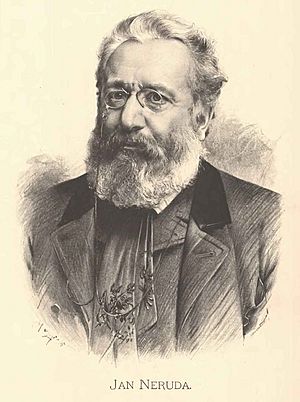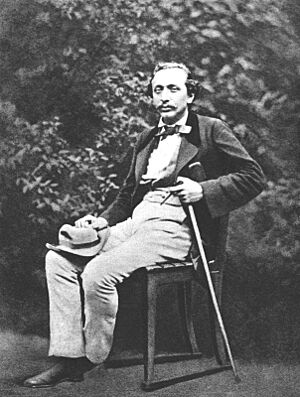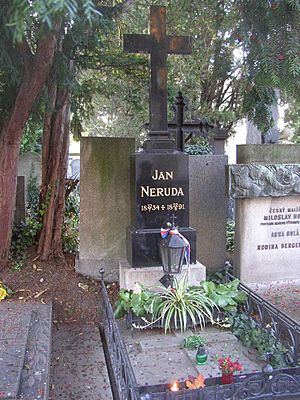Jan Neruda facts for kids
Quick facts for kids
Jan Neruda
|
|
|---|---|

Portrait by Jan Vilímek
|
|
| Born | Jan Nepomuk Neruda 10 July 1834 Prague, Austrian Empire |
| Died | 22 August 1891 (aged 57) Prague, Austria-Hungary |
| Resting place | Vyšehrad Cemetery |
| Occupation | Poet, journalist |
| Nationality | Czech |
| Genre | Literary realism |
| Literary movement | May school |
| Notable works | Povídky malostranské |
| Spouse | Anna Holinová |
| Partner | Karolína Světlá |
Jan Nepomuk Neruda (born July 9, 1834 – died August 22, 1891) was a famous Czech writer, poet, and journalist. He was also an art critic. Neruda was one of the most important writers of Czech Realism. He was also a member of a group of writers called the "May School".
Contents
Early life and studies
Jan Neruda was born in Prague, which was then part of Bohemia. His family lived in the Malá Strana district. His father was a small grocer.
When Jan was four, his family moved to Ostruhová Street. This street is now called Nerudova Street in his honor. Their house was known as "U Dvou Slunců" (At the Two Suns).
Neruda started school in 1845 at a local Grammar school. In 1850, he continued his studies at the Academic Grammar School. He enjoyed reading writers like Heinrich Heine, Lord Byron, and William Shakespeare. He also liked Czech writers such as Karel Hynek Mácha.
After finishing school, he tried to study law but it did not work out. He worked briefly as a clerk, but he was not happy. So, he decided to study philosophy and philology at Charles University.
He then worked as a teacher until 1860. After that, he became a freelance journalist and writer. This meant he worked for himself.
Journalism and travels
Neruda started his writing career at Národní listy (National Sheets), a newspaper. He also wrote for other magazines like Obrazy života (Pictures of Life) and Čas (Time). He also contributed to Květy (Blossoms) and Lumír.
He became a leader for a group of writers. This group included Karolina Světlá and Vítězslav Hálek. They wanted to continue the work of Karel Hynek Mácha. They published their writings in a book called Máj.
Around 1871, some people unfairly called Neruda a "Traitor to the Nation". Because of this, he decided to travel for a while. He visited countries like Italy, Greece, France, and Egypt. He wrote detailed notes about his journeys. These notes show that he was a very good observer of people and places.
From 1883 until he died, he lived in New Town, Prague.
Personal life
Neruda was a quiet person and preferred to be alone sometimes. However, he was good friends with the famous composer Bedřich Smetana.
Neruda never married. But he had close relationships with two women: Anna Holinová and Karolina Světlá.
Anna Holinová was his first love. Many of his poems were written for her. Through her father, Neruda met other important Czech writers like Božena Němcová.
His second close friend was Karolína Světlá, who was also a writer. They supported each other with their writing. She also helped him financially when he needed it.
Neruda was very close to his mother. When she died in 1869, it made him very sad. This sadness showed up in his later writings.
Career as a writer
In his work, Neruda strongly supported the Czech National Revival. This was a movement to bring back the Czech language and culture. He also promoted Czech nationalism, which means pride in the Czech nation.
He took part in many important cultural and political discussions of his time. He became known as a thoughtful and sensitive critic. Along with Vítězslav Hálek, Neruda was one of the most important writers of new literary styles.
Death and legacy
From 1880, Neruda suffered from health problems. In the winter of 1888, he broke his kneecap after slipping on ice. After this, he needed help to send his articles to the Národní listy newspaper.
He died on August 22, 1891. He passed away from problems with his digestive system.
He was buried at Vyšehrad Cemetery in Prague. His funeral was a big event. Many people came to show their pride in the Czech nation.
After his death, Ostruhová Street, where he lived, was renamed Nerudova Street in his honor.
The famous Chilean poet, Ricardo Eliecer Neftalí Reyes Basoalto, chose the name Pablo Neruda to show his admiration for Jan Neruda.
In 2009, astronaut Andrew J. Feustel took a copy of Neruda's book Cosmic Songs into space on the STS-125 space shuttle mission.
The Jan Neruda Grammar School is named after him. An asteroid discovered in 1969 was also named 1875 Neruda in his honor.
Works
Poetry
- Hřbitovní kvítí (“Graveyard Flowers”) – This was his first book of poems, published in 1858. It shows feelings of sadness and loneliness. It also talks about social problems like poverty.
- Knihy veršů (“Books of Verses”) – Published in 1867. In this book, he is less sad. He finds meaning in working for his Nation. It also shows his love for his parents. This book has three parts: 1. Kniha veršů výpravných (“Book of Narrative Verses”), 2. Kniha veršů lyrických a smíšených (“Book of Lyrical and Mixed Verses”), and 3. Kniha veršů časových a příležitostných (“Book of Time and Occasional Verses”).
- Písně kosmické (“Cosmic songs”) – Published in 1878. In these poems, Neruda feels more hopeful. He writes about new science and technology. He celebrates space and the human desire to learn.
- Balady a romance ("Ballads and Romances") – Published between 1878 and 1883. These poems often mix up what a ballad and a romance usually are. They tell stories from the Bible or old legends. Some popular ones are Romance štědrovečerní (“Christmas Romance”) and Romance o Karlu IV. (“Romance about Charles IV.”).
- Prosté motivy ("Plain Themes / Simple Motifs") – Published in 1883. This book is like his personal diary. It connects human life with the seasons. Spring is youth, summer is adulthood, autumn is old age, and winter is death.
- Zpěvy páteční ("Friday Songs") – Published in 1896, after his death. This is considered one of his best works. It compares the life of the nation to a great journey. It shows a strong love for the nation and looks back at Czech history, especially the Hussite movement.
Prose
- Arabesky – His first book of prose, published in 1864. It is a collection of short stories. These stories focus on descriptions, thoughts, and conversations rather than just the plot. They often feature unusual characters.
- Různí lidé (“Different People”) – This book contains stories and descriptions of people he met while traveling abroad.
- Trhani – A novel about railroad workers.
- Pražské obrázky (“Pictures of Prague”) – This book describes the lives of poor people in Prague.
- Povídky malostránské (“Tales of the Lesser Quarter”) – This is his most famous prose work, published in 1877. It paints a picture of Prague's Lesser Quarter before 1848. The stories take readers to the streets, shops, and houses of the area. They show typical people from the Czech middle class. Neruda uses humor to describe their lives.
- Praha (“Prague”)
Theatre plays
- Ženich z hladu (“Groom from hunger”)
- Prodaná láska (“Sold love”)
- Merenda nestřídmých
- Francesca di Rimini
- Žena miluje srdnatost
- Já to nejsem (“It’s not me”)
Feuilletons
- Žerty hravé a dravé (“Playful and predatory jokes”)
- Studie krátké a kratší (“Short and shorter studies”)
- Menší cesty (“Smaller trips”)
- Obrazy z ciziny (“Pictures from abroad”)
Journalism
- Obrazy z ciziny (“Pictures from abroad”)
- Rodinná kronika (“Family chronicle”)
See also
 In Spanish: Jan Neruda para niños
In Spanish: Jan Neruda para niños



